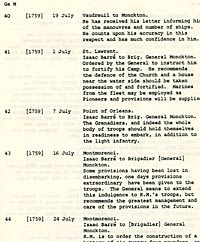Catalogues & Finding Aids
Archives and manuscripts are catalogued differently from library collections. In libraries, items relating to a particular subject are brought together into one place. In contrast, archives and manuscripts are kept as they were found, in their original groupings. This is because it is important for researchers to understand where a particular document came from, and its context in relation to other documents found with it.
The basic unit of an archive is a collection (sometimes called a 'fonds'), which is a group of items created or collected by one particular person or organisation. Related collections or documents might be found in the same repository or in another archive altogether. For instance, lawyers would draw up two copies of any particular title deed - one for the seller and one for the purchaser of the land. It is quite possible for both to have survived, but to be in different archive repositories, because the deeds were passed down through two different families.
Items within collections are usually arranged into a logical order and divided up into a number of series. Family and estate collections, for instance, might contain series such as 'Title Deeds', 'Maps and Plans', 'Rentals', 'Correspondence' and 'Personal Papers'. Where possible, the original order in which the items were kept by the creator of the archive is maintained. Where this cannot be determined, archivists usually arrange the items by type or format, in chronological order, or in some other way which will be easy to use.


Traditional archive catalogues
Traditionally, each collection had a typed or printed catalogue which could be seen in the reading room of the particular archive office. Copies of many catalogues from all over the UK can also be found in The National Archives Reader Enquiries Room at Kew.
The records are described in the catalogue in the order in which they are arranged. The level of detail given about each individual item varies between catalogues. Some older catalogues describing medieval or early modern documents provide very full summaries of each item in chronological order. These catalogues are often called 'calendars'. Other catalogues describe entire bundles of documents very briefly. Catalogues of correspondence usually list the writer, the recipient and the date, but they may not give any indication of the content of the letter. Some catalogues are supplemented by indexes.
Peel Art Gallery, Museums and Archives wrote a detailed blog post about using archival finding aids, including citing one of our collections as an example: https://peelarchivesblog.com/2016/02/29/how-do-archivists-describe-collections-or-how-to-read-a-finding-aid/
Online catalogues
It is now common for archive offices to have some, if not all of their catalogues available electronically. Electronic catalogues mean that users can search for relevant documents in seconds. They may also be able to search across a number of catalogues at the same time.
Some electronic catalogues are only available in the reading room of that particular archive office. Others are made available online. The websites of archive offices will include links to any online catalogues, and usually some advice as to whether they are comprehensive or still in development.
Here are some examples of online catalogues:
Networked online catalogues
Some institutions have collaborated to create combined online catalogues. On these websites, detailed catalogues from multiple archive offices can be browsed or searched at once. Here are three of the most prominent and useful examples:
- The National Archives: Discovery
Discovery now contains detailed catalogues of a selection of archives held in over 400 repositories in England and Wales, including some from The University of Nottingham, which were created in the early 2000s as part of the A2A (Access to Archives) project. It offers searches by keyword, dates and repository. The Discovery catalogue should be used in conjunction with other searches, as the descriptions may have been superseded by further cataloguing work in the individual repositories
- National Union Catalogue of Manuscript Collections (NUCMC)
This is a gateway, provided by the Library of Congress, to the OCLC Catalog of archival and manuscript collections in libraries, principally in North America but from all around the world
Using Online Resources
- Most online resources will allow researchers to search for people, places or a subject term, as well as do a 'free text' search
- Take a methodical approach to searching: this will avoid wasting time on material which is not relevant to your topic area. Look for variants of words and spellings if you do not find a result first time
- Be aware that each online resource operates slightly differently. Read the 'help' pages to get hints on optimising your search
- There are also differences in the level of detail provided. Sometimes a whole document has been digitised and transcribed for you to read onscreen; but often there may only be a very brief description of a whole bundle of documents
- Don't give up! Not everything has been made available electronically. Contact an archivist for more advice on relevant sources
Next page: Using archival material